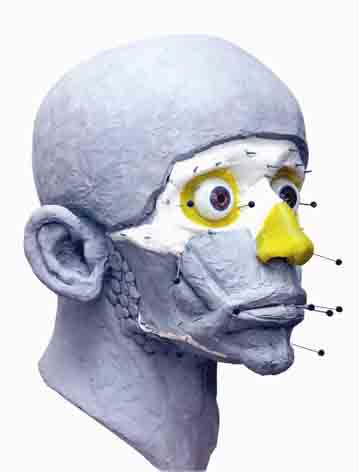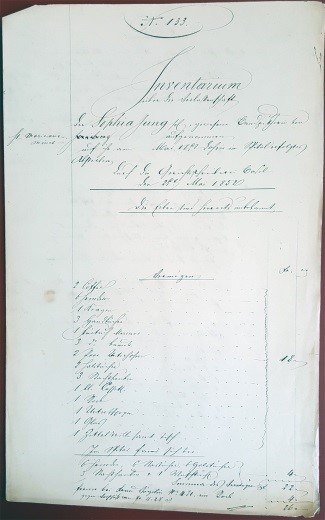Who lays the foundations?

Reconstruction of Theo the pipe smoker
The citizen research project Basel-Spitalfriedhof emerged in 2012 from the research project Theo the Pipe Smoker, in which a large team of volunteer co-workers transcribed historical sources to identify the still nameless pipe smoker. Since 2007, the Theo team has also been transcribing medical records and hospital data from the Bürgerspital Basel.
The citizen research project is designed as a citizen science project. It supports the ongoing archaeological-anthropological and historical research on the skeletons found in the hospital cemetery from the mid-19th century by digitally indexing the associated historical data sources and making them accessible to researchers. This will create the basis for the historical contextualization of anthropological research and the closing of research gaps. In this context, collaboration is being sought with the Basel History Association, which is planning a project to comprehensively reappraise the city's history.

Work in the Basel State Archives
The State Archives of Canton of Basel-Stadt preserve an extensive corpus of data on the social history of the 19th century that is unique in its wealth and completeness. These include patient data (from 1842), medical records (from 1840), inheritance inventories (from 1801), settlement control (from 1840) (Lorenceau dissertation, Pdf), fire records (from 1850), censuses (1840 to 1880) and the housing survey of 1889. The civic research project is currently aiming to complete the censuses and fire records of Basel. The results will be made available to researchers online.
Register of patients and benefactors: admissions and discharges, 1808-1870 (StABS Spital V 10)

Hospital admissions and discharges in the week from March 23 to 29, 1845. Three puerperas were recorded in this week. © Photo G. Hotz
The hospital's admissions and discharges were recorded weekly in the register of patients and nursing staff, as well as the number of co-workers working in the hospital. In addition to details of patients' appointments and who was responsible for paying the weekly hospital flat rate of 3.50 francs (medical department) and 4.00 francs (surgical department), it was also noted in which departments the sick and nursing patients were admitted. The weekly births (puerperas) were also listed. The register of patients and nursing patients allows a complete reconstruction of patient movements over a time horizon of more than 60 years. Particularly valuable is the fact that both the old hospital on the thresholds (behind the Barfüsserkirche/Freie Strasse) and the new Bürgerspital (from 1842) are documented in this way and the changes in the social composition(see Pavel 2016) and geographical origin of the hospital population become tangible.
Medical records (1840-1868)

Medical file with a caricature depicting the attending physician Karl Gustav Jung, © Staatsarchiv Basel
From 1840, the hospital doctors kept medical records for every patient in the medical department and from 1862 also for the surgical department. From 1868, the records of the maternity ward are also archived in full in the Basel State Archives. With these medical reports, the hospital doctors created an academic set of tools to record their experiences of the various diseases and their treatments for their colleagues. The Basel Hospital Cemetery research project has transcribed almost 1,000 of these files.
Censuses 1850, 1860 and 1870

Data from the 1860 census, © Basel State Archives
Here you can download the previously unpublished data of the 1850 census and a guide to the data (data indexing: Verena Fiebig-Ebneter. For the clear data in the form of an Excel file, please contact the project management).
1870 census Status: under development
Status of indexing: 70%
Here you can download the detailed instructions "Data indexing 1870 census".
Inheritance inventories

Inheritance inventory (1st of 3 pages) of Sophie Jung (1822-1852), former band cleaner of St. Marie-aux-Mines (F), © StABS Gerichtsarchiv PP 1.129, Inventar 133, photo G. Hotz
The inheritance inventories 1840 to 1868 of the court inventory PP1 provide a direct insight into the financial situation of people who died in the hospital, among others. Such an inventory is not available for all patients, but these documents nevertheless represent an irreplaceable treasure trove of information. In addition, files on liquidations, bankruptcy proceedings and other matters also provide information on financial living conditions in Basel.
Alphabetical inheritance register 1840-1868
Chronological inheritance register 1840-1868
Co-worker in the citizen research project

The citizen research project is looking for volunteer staff for transcriptions, recording censuses and other tasks. The project team meets three to four times a year for guided tours or presentations followed by an aperitif(team meetings 2007-2017). Anyone who was involved in the project is invited to all events. The meetings take place in an informal setting and serve the purpose of continuing education within the project framework. If you are interested, please contact Gerhard Hotz or Marina Zulauf-Semmler for further information.
Basel hospital cemetery citizen research project team
Management
Gerhard Hotz
Marina Zulauf-Semmler
Verena Fiebig-Ebneter
Liselotte Meyer
Angelo Gianola
Historical counseling
Beatrice Schumacher
Photography
Angelo Gianola
IT support and data cleansing
Daniel Zulauf, Michaela Klaus, Michael Herber, Regula Schneider, Hans-Rudolf Schulz and Anja Walther
Genealogy team
Marina Zulauf-Semmler (Head), Marie Louise Gamma-Liechty, Diana Gysin, and Odette Haas, Ludwig Huber and Jürgen Rauber
General practitioner team
Jürg Gartmann, Hansruedi Banderet, Heiner Bangerter, Peter Nussberger, Heinz Rüegg, Bruno Santschi and Lukas and Jaqueline Schaub
Hospital data team (incl. patient and nursing home register)
Verena Fiebig-Ebneter, Verena Grunauer, Rolf Bretz and Liselotte Meyer
Census and housing survey team
Verena Fiebig-Ebneter, Yvonne Bächle, Susan and Roger Blatter, Waldemar Braun, Heidi Bösch, Marianne Fischer, Fritz Häsler, Else Mühldorfer and Felicitas Ruch
Fire insurance files team
Beat Meyer
Inheritance inventory team
Marina Zulauf-Semmler (head), Odette Haas, Ludwig Huber, Susi Schläpfer, Christel Sitzler and Helena Vogler
Baptismal register team
Baptismal register of the Bürgerspital (1842 - 1870): Marina Zulauf-Semmler and Odette Haas
Team "Name register of the marriage court records (1840 - 1870)"
Saskia Ernst
Identification of historical medical manuscripts in the medical records
Hanns Walter Huppenbauer
Medical terminology
Angelo Gianola and Helena Vogler
Pharmacist team - pharmaceutical terminology
Ingrid Hefti and Christine Küpfer
Transcription team
Marina Zulauf-Semmler (head), Margaretha Avis, Erich Bär, Werner Betz, Rolf Bretz, Maritta Bromundt, Kathrin Decrue, Katharina Matt Eder, Saskia Ernst, Ursula Fink, Hans Peter Frey, Verena Grunauer, Ingrid Hefti, Dascha Herber, Annemarie Hitz †, Bernd Holtze †, Rolf Hopf, Ludwig Huber, Hanns Walter Huppenbauer, Lara Indra, Hiroko Känel, Rosemarie Kuhn, Eva Löhnert Herzog, Paul Meier, Victor Meier, Franziska Meili, Véronique Muller, Jörg Müller, Urs Müller, Heinz Ochsner, Jessica Pabst, Walter Rehm, Cécile Rollé, Gudrun Rubli, Susi Schlaepfer, Ursula Siegrist, Christel Sitzler, Walter Stalder, Beat Stadler, Verena Thöni, Edgar and Joseph Uebelhart †, Helena Vogler, Gisela Weiche † and Susanne Weyermann.
Theo-Team website
Helena Vogler
Assistance and documents for transcribing, glossary of old disease names and information on future and past events including photo galleries can be found on our Theo-Team website.
Genealogy and skeletons
In the Genealogy and Skeletons project, the genealogy team records the family backgrounds of selected skeletons from church records, baptismal registers and other historical sources. The aim is to record three generations: Parents, siblings and children (first subsequent generation). In the case of a married person, the family of the spouse is also recorded. The genealogical research serves the social localization of historical persons. Special interest is given to questions of geographical origin, demography and social mobility. Did social advancement or decline take place within the generations studied? How high is the inter-family mortality rate? But questions about the birth rate of women also play a central role. Here, genealogical research was one of the cornerstones of Gabriela Mani's dissertation. Genealogy represents a separate branch of knowledge in historical research (Ernst Opgenoorth & Gerhard Schulz, Einführung in das Studium der neueren Geschichte, 6th edition, Paderborn 2001).
Here you can download a publication on research in the field of anthropology and genealogy.
For reasons of descendant protection, genealogical research is limited to the first subsequent generation.
Media - Exhibitions
BaZ article on Babette Saxer and the citizen research project from 3.4.2018
Beobachter article on Theo and the citizen research project from 29.3.2018
Spiegel article on Theo and the citizen research project from 23.12.2017
BaZ article on the citizen research project from 25.9.2017
1816 - the year without a summer. Exhibition on the crisis and famine of 1816. The Citizens' Research Project has contributed to the exhibition with its current research on Susanna Hunziker-Widmer. The exhibition shows parts of Susanna Hunziker-Widmer's skeleton in the context of the holding lines in her thigh.
Article on the volunteer work in the Coop newspaper of 24.2.2009
Archive Archives Exhibitions
Einstein goes in search of his ancestors. SRF-Einstein documentary (41 min) on the identification of the Barfüssermummy from 25.1.2018
Mummies - the fight against decay. SRF-Einstein documentary (36 min) on the mummy exhibition from 15.9.2016
Mummies - riddles of time. Special exhibition at the Natural History Museum Basel 15.9.2016 - 1.5.2017. With a contribution from the genealogy team on the identification of the Barfüsser mummy.
BASEL , 1855 n. CHR. On the margins of society. Exhibition accompanying the "Rescue and educational excavation in the hospital cemetery" Basel - St. Johannspark, March 19 - May 30, 2015
Basel - State Archives, October 5 - December 4, 2015
Liestal - State Archives January 11 - March 18, 2016
Basel - Bone work - When skeletons tell stories" 26.10.2011-2.9.2012, exhibition at the Natural History Museum
Quick Links
Social Media
